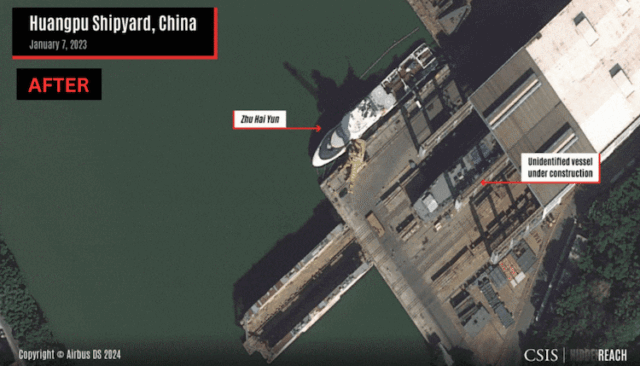
Researchers at the Center for Strategic and International Studies (CSIS) have discovered a high-tech Chinese surveillance vessel circumnavigating Taiwan which went unreported in late 2023.
Zhu Hai Yun, which bristles with advanced monitoring and surveillance equipment, charted a course that appears intended to “challenge and probe the environment around the island,” per the maritime experts.
Earlier this month, reports of a Chinese spy ship Xiang Wang Hong 03’s covert operations in the Indian Ocean and its port call at Male dominated news headlines.
The report highlights the dual application of Chinese research vessels often intertwined with military research. As per the analysis of satellite imagery and other open-source information, CSIS reports that “the lines separating the Zhu Hai Yun and the People’s Liberation Army (PLA) are exceedingly blurred.”
The relationship between Taiwan and China can best be described as “complicated” although many experts believe there is little reason to believe that a full-blown war will break out owing to economic repercussions.
However, the possibility of limited Chinese aggression can not be completely ruled out. Since 2020, the balance of military presence in the Taiwan strait underwent a gradual but profound shift in China’s favor with the PLA’s increased presence around Taiwan raising the risk of an accidental confrontation.
ZHU HAI YUN
Zhu Hai Yun is just one of dozens of Chinese research vessels that scour the world’s oceans collecting data on the marine environment. While China claims that the data is critical to civilian, scientific and commercial research, experts believe it also supports military intelligence.
What sets the Zhu Hai Yun apart, even among China’s most sophisticated research fleet, is its advanced capabilities with the vessel’s navigation and control systems reportedly supported by artificial intelligence software to work for extended period without human interference.
Engineered to act as a “mothership,” it can carry and deploy over 50 unmanned vehicles—encompassing air, surface, and underwater drones—directly from its deck while in motion.
With the Zhu Hai Yun as the hub, these smaller platforms can simultaneously survey a three-dimensional area spanning 160 kilometres across, 4,000 meters above, and 1,500 meters below the ocean’s surface and has a dual-use application.
“The USVs and undersea gliders carried on board the Zhu Hai Yun are equipped with advanced instrumentation such as side-scan sonar, which Chinese naval researchers have identified as useful for detecting undersea targets like mines and submarines. Other systems, like aerial drones, can be used to survey or monitor target areas from the skies,” mentions the CSIS report.
According to Brian Hart, senior research fellow at CSIS, the activities of Zhu Hai Yun came to light following their analysis of Chinese research vessel activities in the Indian Ocean Region.
Earlier this year, a Chinese spy ship Xiang Wang Hang 03 was reported conducting surveillance activities near the EEZ of India. As per the maritime data, the ship meandered in a semantic zig-zag pattern just outside exclusive economic zones of India, the Maldives and Sri Lanka for over three weeks.
The key source of concern is the ability of such a survey ship, while purportedly conducting research and maritime tracking activities in the Indian Ocean region (IOR), to map the ocean’s seabed and study maritime currents and oceanographic trends — data which can be used for a broad range of scientific research, but also for naval warfare.
INCREASED SURVEILLANCE NEAR TAIWAN
The Zhu Hai Yun’s vigilant patrolling of the 24-nautical mile zone adjacent to Taiwan underscores a critical development. In recent years, the People’s Liberation Army (PLA) has intensified its presence near the island, deploying warplanes and warships ever closer to this maritime boundary. This tactic aims to gradually weaken Taipei’s assertions of sovereignty over its adjacent waters and airspace.
Under the UN Convention on the Law of the Sea, states may claim a contiguous zone up to 24 nautical miles from their coastline, giving them resource rights and jurisdiction over the surface and floor of that ocean area.
Another Chinese research ship, the Da Yang, operated off Taiwan’s east coast from February 15 to 17, according to information from Taipei confirmed by ship tracking data.
Ke Xue, Hai Da Hao, Xue Long, Jia Geng, Xiang Yang Hong 03, Xiang Yang Hong 10, Yan Ping 2, Xiang Yang hong 06, Tan Suo hi Yao, Da Hong yao, Zhi Hai Yun, Ke Xue San Hao, Hai Da hao, Hai Yang Di Zhi Jiu Hao are among the 13 vessels that entered Taiwan’s 24 nautical mile zone since 2023.
The Zhu Hai Yun’s close approach to Taiwan’s 24-nautical mile (nm) contiguous zone is significant. In recent years, PLA planes and warships have increasingly pushed closer to the island’s contiguous zone to erode Taipei’s claims of sovereignty over its surrounding waters and airspace.
During large-scale military exercises around Taiwan in April 2023, several PLA vessels intentionally intruded into Taiwan’s contiguous zone in a rare and provocative maneuver.
CHINESE WARPLANES IN TAIWAN AIR DEFENSE ZONE
Starting in 2020, Taiwan’s Ministry of National Defense started releasing daily reports on Chinese military operations within the island’s Air Defense Identification Zone (ADIZ)—a buffer extending past Taiwan’s territorial waters and airspace, aimed at early detection of incoming Chinese aircraft or missiles.
This move responded to escalating pressures from China, which saw PLA aircraft infringing this zone nearly 400 times in 2020 alone. By 2023, these incursions had surged to over 1,700 instances.

In October 2022, following increased incursions after Ms. Pelosi’s visit, Taiwan’s Defense Ministry declared that any PLA aircraft entering Taiwan’s territorial airspace or waters—within 12 nautical miles of its shores—would be considered a “first strike,” implying they would be intercepted.
No PLA aircraft incursions have been reported since then. However, China has challenged Taiwan’s resolve by launching at least 27 balloons into its airspace since the year’s start.
At least 11 Chinese coastguards were detected around Taiwan, Taipei’s Defence ministry reported on Wednesday, the highest number this year as a row between the island and China over a fatal fishing boat incident dragged on.
A Chinese speedboat carrying four people capsized on February 14 near Taiwan’s Kinmen islands while being pursued by the Taiwanese coast guard, throwing all on board into the water.
Tune In




































